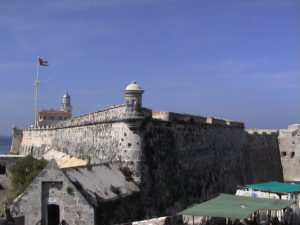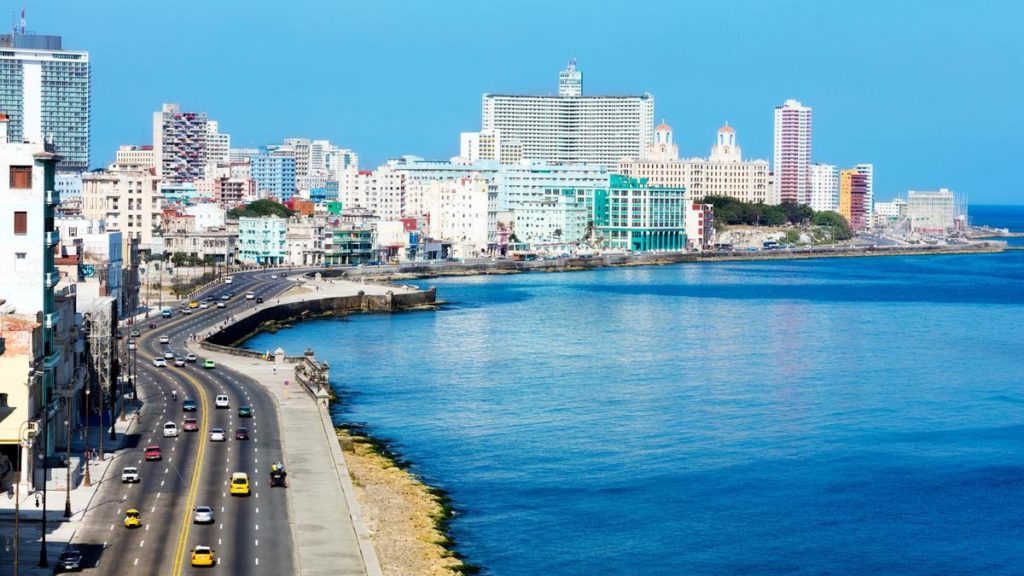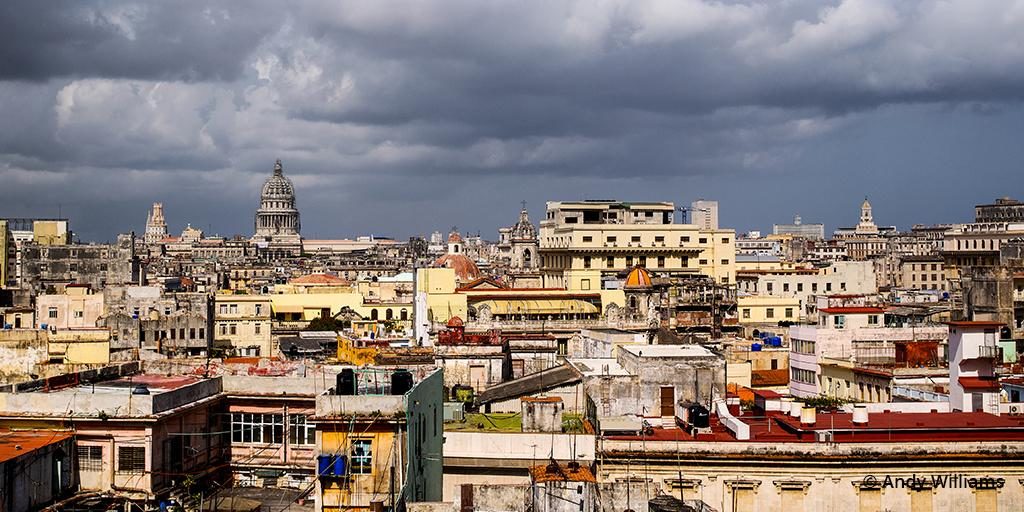MORRO CASTLE (CASTILLO DEL MORRO), GUARDIAN AT THE ENTRANCE OF THE OLD CITY OF HAVANA. PHOTOS.
Morro Castle (Spanish: Castillo de Los Tres Reyes Magos del Morro), named after the three biblical Magi, is a fortress guarding the entrance to Havana bay in Havana, Cuba.
The Morro fortress in Havana shares its name with Castillo de San Pedro de la Roca in Santiago de Cuba and the Castillo de San Felipe del Morro in San Juan, Puerto Rico. In this case, the Spanish “morro” means a rock that is very visible from the sea and therefore serves as a navigational landmark. Perched on the promontory on the opposite side of the harbor from Old Havana, it can be viewed from miles around as it dominates the port entrance. Built initially in 1589 in response to raids on Havana harbor, el Morro protected the mouth of the harbor with a chain being strung out across the water to the fort at La Punta.
MORRO CASTLE HISTORY
The design was drawn up by the Italian engineer Battista Antonelli; originally under the control of Spain, the fortress was captured by the British in 1762 and was returned to the Spanish under treaty terms a year later.
It first saw action in 1762, while under the command of Luis Vicente de Velasco e Isla. The British expedition against Cuba under Lord Albemarle landed in Cojimar to the east of Havana and attacked the fortress from its landward side. The fort fell when the British successfully mined one of its bastions. When the British handed the island back in 1763 to Spain, the fortress at La Cabaña was built to prevent this from happening again.
Inside the gates is an exhibition on the lighthouses of Cuba – El Morro once housed a school for lighthouse keepers. There was actually a watchtower here until the British blew it up during their successful siege in 1762. The Faro Castillo del Morro lighthouse was added in 1846.
The cannons around the fort are now badly rusted, but the walls are well preserved. The fort has central barracks up to four stories high. A small underwater archeology exhibition is also located here. Noteworthies are the old latrines and their chute into the sea, as are the two sets of doors and the drawbridge mechanism. The current harbor master’s office is still housed in the fortress. A plaque dedicated by the ambassador of the United Kingdom commemorates the 1762 siege, and a small memorial is located between two strong powder rooms in the northeast bastion.
A small turret at the end of the wall offers views of the sea crashing onto the rocks 20 meters below, and of the huge dry moat. The opposite side of the moat holds more modern guns and cannons, La Bateria de Velasco, and offers a sweeping view down to Cojimar.
EL CAÑONAZO DE LAS NUEVE
The complex is now part of a historical park, along with the El Morro fortress, and houses several museums open to the public. Every night a cannon is fired at 9 pm, the so-called “El Cañonazo de las 9” is a leftover custom kept from colonial times signaling the closure of the city gates.
MORRO CASTLE APPEARANCES IN CULTURE
– Morro Castle can be seen in the background of John Singleton Copley’s oil painting Watson and the Shark (1778).
– Morro Castle appears in the movie The Ghost Breakers (1940), in the background as Bob Hope and Paulette Goddard enter the harbor by ship.
– The climactic scenes from The Big Boodle (1957) starring Errol Flynn were shot at Morro Castle in pre-Castro Cuba.
– The Cuban writer José Antonio Echeverría (1815-1885) published his only novel, Antonelli (1839), in the periodical La Cartera Cubana in three parts. A historical novel in the tradition of Walter Scott, Antonelli describes the love triangle among Antonelli, a Spanish soldier, and the planter’s daughter they both love. Morro Castle is the setting for many of the book’s events, including its tragic finale.
CASTRO DICTATORSHIP PRISON
During his life, the Castro regime imprisoned the Cuban poet and novelist Reinaldo Arenas (1943-1990) at El Morro Castle for criticism of the government. The film version of Arenas’s autobiography, Before Night Falls (2000), starring Javier Bardem, features scenes set in El Morro Castle prison. (A fortress in Mexico City doubled for the prison since the filmmakers were not allowed to film in Cuba.)
CASTILLO DEL MORRO, GUARDIÁN A LA ENTRADA DE LA VIEJA CIUDAD DE LA HABANA. PHOTOS
El Castillo del Morro (Castillo de Los Tres Reyes Magos del Morro), que lleva el nombre de los tres magos bíblicos, es una fortaleza que custodia la entrada a la bahía de La Habana en La Habana, Cuba.
La fortaleza del Morro en La Habana comparte su nombre con el Castillo de San Pedro de la Roca en Santiago de Cuba y el Castillo de San Felipe del Morro en San Juan, Puerto Rico. En este caso, el “morro” español significa una roca que es muy visible desde el mar y por lo tanto sirve como un punto de referencia para la navegación. Encaramado en el promontorio en el lado opuesto del puerto de La Habana Vieja, se puede ver desde millas a la redonda ya que domina la entrada del puerto. Construido inicialmente en 1589 en respuesta a las redadas en el puerto de La Habana, el Morro protegió la boca del puerto con una cadena tendida sobre el agua hasta el fuerte de La Punta.
HISTORIA DEL CASTILLO DE MORRO
El diseño fue realizado por el ingeniero italiano Battista Antonelli; originalmente bajo el control de España, la fortaleza fue capturada por los británicos en 1762 y fue devuelta a los españoles en virtud de un tratado un año después.
Entró en acción por primera vez en 1762, bajo el mando de Luis Vicente de Velasco e Isla. La expedición británica contra Cuba bajo el mando de Lord Albemarle aterrizó en Cojimar al este de La Habana y atacó la fortaleza desde su lado terrestre. El fuerte cayó cuando los británicos minaron con éxito uno de sus bastiones. Cuando los británicos devolvieron la isla en 1763 a España, se construyó la fortaleza de La Cabaña para evitar que esto volviera a suceder.
Dentro de las puertas hay una exposición sobre los faros de Cuba: El Morro albergó una vez una escuela para fareros. En realidad, hubo una torre de vigilancia aquí hasta que los británicos la volaron durante su exitoso asedio en 1762. El faro Castillo del Morro fue agregado en 1846.
Los cañones alrededor del fuerte ahora están muy oxidados, pero las paredes están bien conservadas. El fuerte tiene cuarteles centrales de hasta cuatro pisos de altura. Aquí también se encuentra una pequeña exposición de arqueología subacuática. Destacan las antiguas letrinas y su rampa al mar, así como los dos juegos de puertas y el mecanismo del puente levadizo. La oficina del actual capitán del puerto todavía se encuentra en la fortaleza. Una placa dedicada por el embajador del Reino Unido conmemora el asedio de 1762, y un pequeño monumento se encuentra entre dos fuertes salas de polvo en el bastión noreste.
Una pequeña torreta al final de la pared ofrece vistas del mar chocando contra las rocas 20 metros más abajo y del enorme foso seco. El lado opuesto del foso tiene armas y cañones más modernos, La Batería de Velasco, y ofrece una vista panorámica de Cojimar.
EL CAÑONAZO DE LAS NUEVE
El complejo ahora es parte de un parque histórico, junto con la fortaleza de El Morro, y alberga varios museos abiertos al público. Cada noche se dispara un cañón a las 9 de la noche, el llamado “El Cañonazo de las 9” es una costumbre remanente guardada de la época colonial que señala el cierre de las puertas de la ciudad.
APARICIONES DEL CASTILLO DE MORRO EN LA CULTURA
– El castillo de Morro se puede ver en el fondo de la pintura al óleo de John Singleton Copley Watson and the Shark (1778).
– Morro Castle aparece en la película The Ghost Breakers (1940), en el fondo cuando Bob Hope y Paulette Goddard entran al puerto en barco.
– Las escenas culminantes de The Big Boodle (1957), protagonizada por Errol Flynn, se rodaron en el castillo de Morro en la Cuba anterior a Castro.
– El escritor cubano José Antonio Echeverría (1815-1885) publicó su única novela, Antonelli (1839), en el periódico La Cartera Cubana en tres partes. Una novela histórica en la tradición de Walter Scott, Antonelli describe el triángulo amoroso entre Antonelli, un soldado español, y la hija del plantador que ambos aman. Morro Castle es el escenario de muchos de los eventos del libro, incluido su trágico final.
PRISIÓN DE LA DICTADURA CASTRISTA
Durante su vida, el régimen de Castro encarceló al poeta y novelista cubano Reinaldo Arenas (1943-1990) en el Castillo de El Morro por críticas al gobierno. La versión cinematográfica de la autobiografía de Arenas, Antes que anochezca (2000), protagonizada por Javier Bardem, presenta escenas ambientadas en la prisión del Castillo de El Morro. (Una fortaleza en la Ciudad de México se duplicó para la prisión ya que a los cineastas no se les permitió filmar en Cuba).
Agencies/ Wiki/ Internet Photos/ Arnoldo Varona/ www.TheCubanHistory.com
THE CUBAN HISTORY, HOLLYWOOD.



 MORRO CASTLE, Guardian at the Entrance of the Old City of Havana. * CASTILLO DEL MORRO, guardian a la Entrada de la Vieja Ciudad de la Habana. PHOTOS.
MORRO CASTLE, Guardian at the Entrance of the Old City of Havana. * CASTILLO DEL MORRO, guardian a la Entrada de la Vieja Ciudad de la Habana. PHOTOS.








